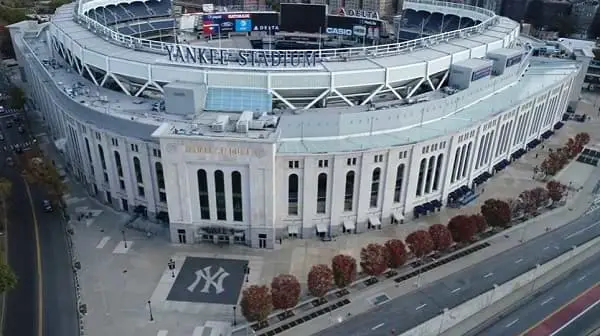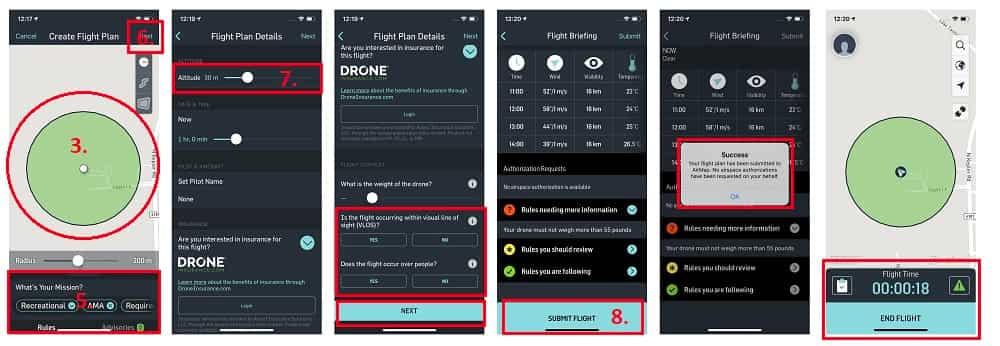
One of the most controversial topics in the drone community is whether or not you are allowed to fly over a stadium with a drone! I’ve done my research and here’s the truth.
The FAA (Federal Aviation Administration) clearly states that flying a drone in and around stadiums during events is prohibited starting one hour before and ending one hour after the scheduled time of an event. These events include but are not limited to:
- MLB
- NFL
- NCAA Div 1 Football
- Nascar, Indy Car, and Champ Series
This ban covers a radius of 3 nautical miles of the stadium and up to 3000 feet above ground level.
However, there are ways you can fly over an empty stadium legally, so keep reading to find out more!
Can You Fly Over An Empty Stadium?

The FAA has prohibited drone flight in and around stadiums an hour before an event, all the way to an hour after the event.
So, does this mean you will never be able to fly a drone over a stadium?
The FAAs rules and regulations only state that enthusiasts are not allowed to fly over stadiums during significant sporting events. This means that you are allowed to fly over empty stadiums with your drone.
IMPORTANT NOTE: If your drone weighs over 250 grams or 0.55lbs, make sure you register it with the FAA. Here’s a guide that will show you how to register your drone as a hobbyist drone pilot.
Because there are no people in a stadium without a sporting event on display, the stadium will be empty, and the temporary flight restriction will be lifted, making a flight over the stadium perfectly legal.
It might not be as exciting as flying a drone over a stadium with a crowd inside it. However, the stadiums are pieces of beautiful architecture, and being able to film them entirely is still fantastic.
Before you launch your drone, though, make sure you’re following other FAA drone laws as well as your local county drone laws.
How Much Can You Get Fined For Flying A Drone Over A Stadium During An Event?
Many people want to record fantastic drone footage, and what is more amazing than an aerial view of a fully lit stadium with thousands of fans cheering on their favorite sports team?
So, you might want to take your drone out for a flight over one of the stadiums as the game is on.
Unfortunately, as I have already stated earlier, flying a drone over sporting events is illegal, and flying a drone over a stadium may result in you paying a fine of up to $250,000, and you could even end up spending up to 3 years in jail!
Quite a price to pay, isn’t it?
If you want to find out exactly how much you could get fined for breaking other laws with a drone by mistake, read this article.
Why Can’t You Fly Over Football Fields?
Using a drone to fly over people is always a risk, and using a drone to fly over a stadium full of people poses some serious risks.
Even though flying a drone is a hobby, after the events that took place on September 11, the FAA (Federal Aviation Administration) set in place a number of rules and regulations that have now made stadiums, airports and other areas “national defense airspace”.
- As a pilot, you are supposed to be aware that it is illegal to fly over a stadium an hour before a sporting event, during the sporting event, and up to an hour after the event has ended. This rule also applies to drones!
- The flight is also prohibited below 3,000 feet above the stadium and within three nautical miles of the stadium. Again, this rule applies to all aircraft, anything from planes to drones.
Can You Get Special Permission to Fly During Events?
You can receive permission to fly around a stadium during a sporting event using the LAANC system, and obtain permission to fly near a stadium.
You can’t, however, fly over the stadium as there are people in it, and it is still prohibited to fly over people with a drone.
The LAANC system, (which stands for Low-Altitude Authorisation and Notification Capability) is a system that allows pilots to notify authorities that they will be flying in a certain area.
This used to only be for commercial drone pilots, but now recreational drone pilots and hobbyists can use it too if they want to fly within restricted air space.
The LAANC is a partnership between the FAA and private companies such as Airmap, DJI, Skyward, and Kittyhawk. It is actually pretty easy to use these applications to request authorization to fly your drone in restricted airspace.
Depending on the airspace and circumstances, it is not guaranteed that you will receive authorization.
Here’s how to apply for LAANC approval on Airmap app:
- Simply download the Airmap app. Download for iPhone here, and android here. Once the app is downloaded, you can create a profile by filling in your details.
- Locate the area that you would like to fly in. Zoom in with your fingers on the map, and find the area you want to fly in.
- Tap and hold your finger on the screen until a circle appears. The circle’s color will indicate if you are allowed to request authorization or not. If the ring is orange, then you are given the ok to request approval to fly.
- Draw path. You will be able to draw your flight path as well as draw your boundaries.
- Mission. The app will ask you what the reason for your flight is, and you need to choose one of the options given.
- Next is the pre-flight checklist. Enter as much info on your flight as possible.
- Tap on Next and you should get a notice and text message letting you know if you are approved to fly in that area or not.

Need a more detailed guide on how to apply for LAANC on Airmap.com? Read my guide here.
What Are Stadium Temporary Flight Restrictions (TRF)?
Sporting events in stadiums and football fields are usually protected by a temporary stadium flight restriction that applies to all aircraft including drones.
So what exactly is a temporary flight restriction?
A temporary flight restriction (TFR) is a regulatory action that temporarily places flight restrictions on certain areas. They last for a set period of time and cover a set radius depending on the event taking place.
This is done to protect the people who are in the area at the time or protect certain property in the area. The TFRs are commonly known as No-Fly Zones and will usually be indicated as such on any mapping app that you use to plot out your flights.
Temporary flight restriction varies in size and can be anywhere from a 3-mile radius to a 30-mile radius. An example of a 30-mile radius TFR is usually the Superbowl. This is a major sporting event in the United States and tens of thousands of people are always in attendance.
Because of this, the FAA puts heavy restrictions in place for aircraft and even extending the TFR to 30 miles.
Do Professionals Use Drones At Sporting Events?
Since drones are not allowed to fly over sporting events, does that mean drones will never be used to film or stream live sporting events like NFL games and Nascar races?
In 2015 the NFL was the first major American sports league that was allowed to fly drones at the various league games. The NFL requested to fly drones over their stadiums as a way to assist their video production team, NFL Films.
The production team used crewed aircraft to capture aerial imagery, but with the introduction of drones, they wouldn’t have to do this anymore and it would make cinematic shots a lot easier.
This approval was limited to using drones in an empty stadium before, but now in recent years, the NFL has been granted permission to use drones during games as well.
Recently, the NFL has been doing some amazing things with drones with the approval of the FAA. Drones are being used to film various NFL documentaries, practices, and now they even use drones to drop footballs onto the field from high distances!
Drones make filming the games a lot easier as well. Before, the teams would have to have different spots available and large poles put up to set up large cameras. Now, they just fly a drone above the players at different angles and capture fantastic cinematic shots of the games.
Drones are also being used during the Super Bowl half time shows and for the annual Pro Bowl Skills Challenge. Hundreds of drones are used to light up the sky, while famous musicians perform on stage.
The drones are all programmed to fly together and using lighting systems, and they create various images like the American Flag or various sponsorship logos.
The addition of drones to the sporting world has made everything easier as well as bringing a new aspect to the camera work and entertainment at these sporting events.
